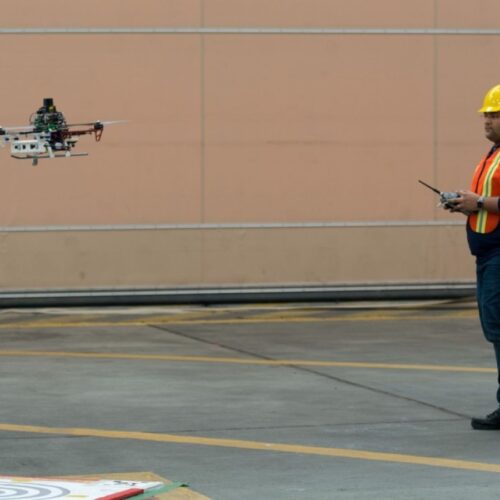This story was published in partnership with the Verge.
Introduction
The Defense Department’s cutting-edge research arm has promised to make the military’s largest investment to date in artificial intelligence (AI) systems for U.S. weaponry, committing to spend up to $2 billion over the next five years in what it depicted as a new effort to make such systems more trusted and accepted by military commanders.
The director of the Defense Advanced Research Projects Agency (DARPA) announced the spending spree on the final day of a conference in Washington celebrating its 60-year history, including its storied role in birthing the internet.
The agency sees its primary role as pushing forward new technological solutions to military problems, and the Trump administration’s technical chieftains have strongly backed injecting artificial intelligence into more of America’s weaponry as a means of competing better with Russian and Chinese military forces.
The DARPA investment is small by Pentagon spending standards, where the cost of buying and maintaining new F-35 warplanes is expected to exceed a trillion dollars. But it is larger than AI programs have historically been funded and roughly what the United States spent on the Manhattan Project that produced nuclear weapons in the 1940s, although that figure would be worth about $28 billion today due to inflation.
In July defense contractor Booz Allen Hamilton received an $885 million contract to work on undescribed artificial intelligence programs over the next five years. And Project Maven, the single largest military AI project, which is meant to improve computers’ ability to pick out objects in pictures for military use, is due to get $93 million in 2019.
Turning more military analytical work – and potentially some key decision-making – over to computers and algorithms installed in weapons capable of acting violently against humans is controversial.
Google had been leading the Project Maven project for the department, but after an organized protest by Google employees who didn’t want to work on software that could help pick out targets for the military to kill, the company said in June it would discontinue its work after its current contract expires.
While Maven and other AI initiatives have helped Pentagon weapons systems become better at recognizing targets and doing things like flying drones more effectively, fielding computer-driven systems that take lethal action on their own hasn’t been approved to date.
A Pentagon strategy document released in August says advances in technology will soon make such weapons possible. “DoD does not currently have an autonomous weapon system that can search for, identify, track, select, and engage targets independent of a human operator’s input,” said the report, which was signed by top Pentagon acquisition and research officials Kevin Fahey and Mary Miller.
But “technologies underpinning unmanned systems would make it possible to develop and deploy autonomous systems that could independently select and attack targets with lethal force,” the report predicted.
The report noted that while AI systems are already technically capable of choosing targets and firing weapons, commanders have been hesitant about surrendering control to weapons platforms partly because of a lack of confidence in machine reasoning, especially on the battlefield where variables could emerge that a machine and its designers haven’t previously encountered.
Right now, for example, if a soldier asks an AI system like a target identification platform to explain its selection, it can only provide the confidence estimate for its decision, DARPA’s director Steven Walker told reporters after a speech announcing the new investment – an estimate often given in percentage terms, as in the fractional likelihood that an object the system has singled out is actually what the operator was looking for.
“What we’re trying to do with explainable AI is have the machine tell the human ‘here’s the answer, and here’s why I think this is the right answer’ and explain to the human being how it got to that answer,” Walker said.
DARPA officials have been opaque about exactly how its newly-financed research will result in computers being able to explain key decisions to humans on the battlefield, amidst all the clamor and urgency of a conflict, but the officials said that being able to do so is critical to AI’s future in the military.
Vaulting over that hurdle, by explaining AI reasoning to operators in real time, could be a major challenge. Human decision-making and rationality depend on a lot more than just following rules, which machines are good at. It takes years for humans to build a moral compass and commonsense thinking abilities, characteristics that technologists are still struggling to design into digital machines.
“We probably need some gigantic Manhattan Project to create an AI system that has the competence of a three year old,” Ron Brachman, who spent three years managing DARPA’s AI programs ending in 2005, said earlier during the DARPA conference. “We’ve had expert systems in the past, we’ve had very robust robotic systems to a degree, we know how to recognize images in giant databases of photographs, but the aggregate, including what people have called commonsense from time to time, it’s still quite elusive in the field.”
Michael Horowitz, who worked on artificial intelligence issues for Pentagon as a fellow in the Office of the Secretary of Defense in 2013 and is now a professor at the University of Pennsylvania, explained in an interview that “there’s a lot of concern about AI safety – [about] algorithms that are unable to adapt to complex reality and thus malfunction in unpredictable ways. It’s one thing if what you’re talking about is a Google search, but it’s another thing if what you’re talking about is a weapons system.”
Horowitz added that if AI systems could prove they were using common sense, ”it would make it more likely that senior leaders and end users would want to use them.”
An expansion of AI’s use by the military was endorsed by the Defense Science Board in 2016, which noted that machines can act more swiftly than humans in military conflicts. But with those quick decisions, it added, come doubts from those who have to rely on the machines on the battlefield.
“While commanders understand they could benefit from better, organized, more current, and more accurate information enabled by application of autonomy to warfighting, they also voice significant concerns,” the report said.
DARPA isn’t the only Pentagon unit sponsoring AI research. The Trump administration is now in the process of creating a new Joint Artificial Intelligence Center in that building to help coordinate all the AI-related programs across the Defense Department.
But DARPA’s planned investment stands out for its scope.
DARPA currently has about 25 programs focused on AI research, according to the agency, but plans to funnel some of the new money through its new Artificial Intelligence Exploration Program. That program, announced in July, will give grants up to $1 million each for research into how AI systems can be taught to understand context, allowing them to more effectively operate in complex environments.
Walker said that enabling AI systems to make decisions even when distractions are all around, and to then explain those decisions to their operators will be “critically important…in a warfighting scenario.”
Read more in National Security
Future of Warfare
The Pentagon tries to win hearts and minds in Silicon Valley
An early stumble prompts the Defense Department to change its approach to the tech community but hasn’t lessened its commitment to put artificial intelligence into weaponry.
Future of Warfare
The military’s weapons are vulnerable to hacking
Cybersecurity tests of new major weapons exposed simple passwords and other big software holes, according to government auditors


Join the conversation
Show Comments